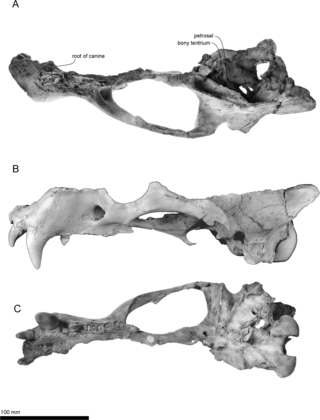
Odobenidae is a family of pinnipeds, of which the only extant species is the walrus. In the past, however, the group was much more diverse, and includes more than a dozen fossil genera.

Balaenoptera is a genus of rorquals containing eight extant species. Balaenoptera comprises all but two of the extant species in its family ; the genus is currently polyphyletic, with the two aforementioned species being phylogenetically nested within it.

Enaliarctos is an extinct genus of pinnipedimorph, and may represent the ancestor to all pinnipeds. The five species in the genus Enaliarctos have been recovered from late Oligocene and early Miocene strata of California and Oregon.

Imagotaria is an extinct monotypic genus of walrus with the sole species Imagotaria downsi. Fossils of Imagotaria are known from the early late Miocene of California.
The San Diego Formation is a geological formation in southwestern San Diego County, California, United States, and northwestern Baja California, Mexico.

Ontocetus is an extinct genus of walrus, an aquatic carnivoran of the family Odobenidae, endemic to coastal regions of the southern North Sea and the southeastern coastal regions of the U.S. during the Miocene-Pleistocene. It lived from 13.6 mya—300,000 years ago, existing for approximately 13.3 million years.

Pelagiarctos was a genus of walrus that lived during the Mid Miocene, approx. 13-15 mya. Its remains have been found in the Sharktooth Hill Bonebed, in Kern County, California. It was originally described as an Otariidae, though it is now usually considered to be a basal Odobenidae.

Carcharodon hubbelli, also known as Hubbell's white shark, is an extinct species of white shark that evolved between 8 and 5 million years ago during the Late Miocene to Early Pliocene epochs. This shark is a transitional species, showing intermediate features between the extant great white shark and the fossil white shark, C. hastalis. C. hubbelli appears to be geographically restricted to the Pacific Ocean, with fossils of C. hubbelli recovered from Peru, Chile, California, and New Zealand. This exclusive distribution suggests a Pacific origin for the great white shark.

Herpetocetus is a genus of cetotheriid mysticete in the subfamily Herpetocetinae. Considerably smaller than modern baleen whales, Herpetocetus measured only 3 to 4 meters in length. Additionally, due to the structure of its jaw, it was unable to open its mouth as wide as modern baleen whales, making it incapable of lunge feeding.

The Purisima Formation is a geologic formation in California that preserves fossils dating from the Late Miocene to Late Pliocene. It stretches from Point Reyes to the Santa Cruz Mountains.

The Capistrano Formation is a geologic formation in coastal southern Orange County, California. It preserves fossils dating back to the late Miocene to early Pliocene, with the Oso Member representing a near-shore environment. Fifty-nine species and varieties of foraminifera are recognized from the Capistrano Formation alongside a diverse array of marine mammals including up to five species of walrus.

Parotodus, commonly known as the false-toothed mako shark, is an extinct genus of mackerel shark that lived approximately 53 to one million years ago during the Eocene and Pleistocene epochs. Its teeth, which are found worldwide, are often prized by fossil collectors due to their rarity. The scarcity of fossils is because Parotodus likely primarily inhabited open oceans far away from the continents. While the placement of Parotodus with the Lamniformes has been debated, most researchers agree it was probably a member of a now extinct shark clade, either a otodontid or a cardabiodont. In any case, it would have been the last members of either group. While originally being suspected of dying out at the very end of the Pliocene, fossils found in the Waccamaw Formation show that it made it to the Pleistocene.

Archaeodobenus is an extinct genus of pinniped that lived during the Late Miocene of what is now Japan. It belonged to the Odobenidae family, which is today only represented by the walrus, but was much more diverse in the past, containing at least 16 genera.

Prototaria is an extinct genus of pinniped that lived approximately 15.97 to 13.65 mya during the Middle Miocene in what is now Japan. It belonged to the family Odobenidae, the only extant species of which is the walrus. Members of the genus Prototaria are believed to be the most basal imagotariine pinnipeds.

Proneotherium is an extinct genus of pinniped that lived approximately 20.43 to 15.97 mya during the Early Miocene in what is now Oregon, U.S. It belonged to the family Odobenidae, the only extant species of which is the walrus.

Nanodobenus is an extinct genus of pinniped that lived approximately 15.97 to 7.246 mya during the Miocene in what is now Baja California Sur, Mexico. It belonged to the family Odobenidae, the only extant species of which is the walrus.
Kamtschatarctos is an extinct genus of pinniped that lived approximately 15.97 to 11.608 mya during the Early Miocene in the Kavran-Ukhtolok Bay of Russia's Kamchatka Peninsula. It belonged to the family Odobenidae, the only extant species of which is the walrus.
Osodobenus is an extinct genus of walrus from the Miocene to Pliocene of California. Osodobenus may have been the first tusked walrus and shows several adaptations that suggest it was a suction feeder, possibly even a benthic feeder like modern species. Three skulls are known showing pronounced sexual dimorphism, with the female lacking the same tusks as the male. Only a single species, Osodobenus eodon, is currently recognized.

Titanotaria is a genus of late, basal walrus from the Miocene of Orange County, California. Unlike much later odobenids, it lacked tusks. Titanotaria is known from an almost complete specimen which serves as the holotype for the only recognized species, Titanotaria orangensis, it is the best preserved fossil walrus currently known.




















